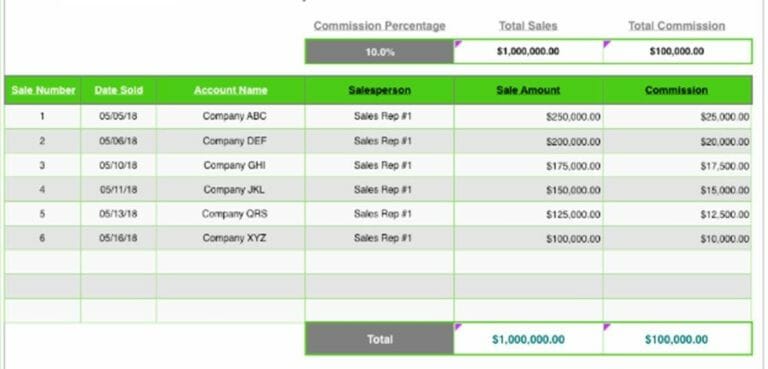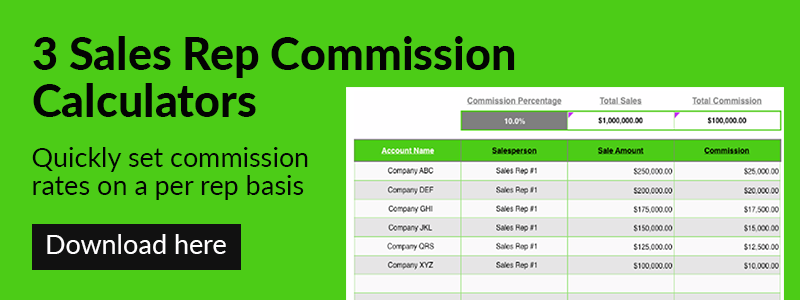Your sales commission structure is a critical piece of your company’s success. It sets the bar for the level of talent that you’ll attract to your sales team.
It seems simple, right? More money = better salespeople? But this isn’t always true.
Higher earning potential through a commission-only comp plan won’t necessarily outweigh the risk a salesperson inherits by not having a guaranteed income source. Elite sales professionals expect to be paid a salary as well.
The number one deciding factor when it comes to looking for a new job is for a higher salary: only 21 percent of employees feel that they are paid fairly and 56 percent of employees leave their current company due to what they deem to be inadequate compensation.
In short, sales reps view their base pay as a sign of how they’ll be valued and treated by the company that employs them.
What Is A Sales Commission Structure?
Sales commission is most commonly known as the variable component of a total sales compensation package. While an on-target earning (OTE) is almost always established, the total commission earned is dependent on each salesperson’s individual goals and their performance.
Your commission structure ties a sales rep’s performance to the amount of money he or she will take home each paycheck. It’s no secret that accountability produces results, and a well-structured commission plan is an excellent way to incentivize top performance.
So, while the salary component of a salesperson’s comp package is fixed and pretty easy to understand, the variable portion has a large amount of room for flexibility and configuration depending on the type of sale and sales process a company has in place.
Because there’s no one size fits all, sales compensation plans come in many different forms. Some of these forms include: salary/hourly + commission, commission-only, tiered commission, residual commission, and variable-rate commission. Of these, the easiest and most commonly used approach is to pay a certain percentage based on the revenue generated from a single sale.
Very simply, a sales rep who closes a deal for $500 with a commission rate of 5% earns $25 per sale.
Why it’s Important to Choose the Right Commission Structure
Your company’s sales commission plan is essential because it helps motivate reps, boost productivity, and decrease rep turnover.
Let’s talk about each of these benefits in greater detail.
Increase motivation
A well-designed sales commission plan will keep your team striving for more—more leads, more sales, and, ultimately, more money in their pockets.
Put yourself in your sellers’ shoes and ask yourself, “which plan would motivate me more? The one that pays me a set sales commission percentage, or one where the percentage increases once I close a certain amount of deals?”
Boost productivity and performance
Motivated employees are often more productive. It makes sense. When your reps are properly incentivized to sell more, they’ll discover the most efficient ways to work in order to maximize their time.
Decrease turnover
Lastly, the right commission structure will help you attract the best salespeople to your company and keep them for longer periods of time.
Studies show that, more often than not, employees leave organizations for one of two reasons: “personal choice” or “compensation”. You can’t do much if your top seller takes a job in Florida to be near their parents. That’s a personal choice.
But you can offer attractive sales commission plans to increase the chances of retaining top sales talent.
10 Typical Sales Commission Structures (With Examples)
In this section, we’ll cover 10 different sales commission structures and why you may, or may not, want to use them.
Commission Only Structure
How it works: Also known as a Straight Commission plan, the Commission Only structure refers to paying reps a set commission whenever they make a sale. Reps don’t earn a base salary or have the opportunity to increase their commission percentage.
Example: A sales rep earns a 25% commission on every product he sells. If, over the course of a year, he sells 30 products at $1,000 each, 20 products at $5,000 each, and 15 products at $10,000 each, he would earn $70,000 in sales commissions.
When to use it: Commission Only structures tend to work best for companies that employ temporary and/or contract salespeople, have short sales cycles, and are able to offer large commissions. Most sales people don’t like this structure, though, because it causes them stress. If they don’t close deals, they don’t earn anything.
Revenue Commission Structure
How it works: Sales reps receive a predetermined commission every time they sell a product or service. This kind of sales commission structure is simple, which is one of the reasons it’s become so popular amongst outside sales teams.
Example: If your company sells a service for $500 that has a commission rate of 10%, a sales rep would earn $50 each time they sell that service.
When to use it: This type of sales commission structure works best with products and services that have a set price point.
They’re also favorable for companies attempting to gain market share or enter a new market because they’re less likely to be focused on profit, and more concerned with achieving a larger business goal.
It should be noted that revenue commission plans typically fail to align with the larger, broader goals of a field sales organization or the unique DNA makeup of a sales team. Therefore, they must be used with caution.
Territory Volume Commission Structure
How it works: The Territory Volume Commission Structure is unique. Sales generated within a territory are tallied up and the commissions generated are split equally amongst all of the sales reps who work within that territory.
Examples: The sales quota for the three reps working within a 100 mile region is $75,000. The first rep sells $30,000 worth of product. The second rep sells $26,000 worth of product. And the third rep sells $22,000 worth of product. In total, the reps generated $78,000 of revenue, exceeding their quota. Because of this, they split the 20% commission equally, earning $5,200 each.
When to use it: For this sales commission plan to work, your sales department must develop a team-first environment and every team member has to be willing to contribute to the overall goal—no lone wolf tactics allowed.
Gross Margin Commission Structure
How it works: Gross margin commission structures are similar to standard revenue commission ones. The difference is that a rep’s commission is calculated using the gross revenue each sale generates rather than the total sale price.
In other words, this commission structure evaluates a product’s sale price and the costs associated with closing a deal to calculate actual profit. Sales reps then earn a commission based off of this number.
Example: If your company’s service costs $1,000 but accrues $500 in costs to complete that transaction, the sales rep would earn a percentage of the remaining $500 in profit.
When to use it: Those supporting a gross margin commission structure usually believe that all sales should benefit the company’s bottom line.
Draw Against Commission Structure
How it works: Think of draws as advanced payments. In this commission structure, sales reps are guaranteed to make a specific amount of money each month, regardless of the number of sales they generate for their company.
Example: A sales rep is eligible for a $2,000 draw in their first month and winds up taking home $1,000 in commission. The sales rep would then keep all of his or her commission in addition to $1,000 from the set draw allowance.
When to use it: The Draw Against Commission Structure is generally best for new hires, ramp periods, long periods of change and uncertainty, and training.
Note: There are a few variations to this structure, most notably, a “borrowed” draw that must be paid back according to the specified terms.
Tiered Commission Structure
How it works: A tiered model is a popular sales commission structure among sales reps—especially those who are top performers and/or highly motivated. In a nutshell, salespeople earn higher commission rates after closing a certain number of deals, or, surpassing a total amount of revenue generated.
Example: A sales rep earns 5% on all products sold up to $10,000 in total revenue generated. Under the tiered model, the same sales rep would begin to earn 8% on all revenue generated after surpassing the $10,000 mark.
When to use it: This sales commission structure is great if you’re looking to scale up your sales department because it incentivizes peak performance and encourages reps to explore new revenue channels such as upsells and cross sells.
Residual Commission Structure
How it works: The Residual Commission structure continues to pay sales reps a commission for as long as the accounts they acquire continue to drive revenue. Because of this, it behooves reps to retain their customers for as long as possible.
Example: A customer agrees to pay your company $2,000 a month in exchange for your services. The sales rep who closed the deal will receive a 5% commission, which translates to $100 a month, for as long as the account remains active.
When to use it: This sales commission structure works best for organizations with ongoing accounts, such as insurance providers, marketing agencies, etc.
Multiplier Commission Plan
How it works: Multiplier Commission Structures can be difficult to set up, but allow companies to create customized compensation plans that truly motivate their sales department to make more sales.
Multiplier plans start with a basic revenue commission percentage that gets multiplied by a predetermined figure depending on a rep’s quota achievement.
Example: A rep makes a basic 5% commission on every sale they generate. This 5% figure is then multiplied by .8 if the rep attains less than 75% of quota (resulting in a 4% commission), .9 if the repp attains 76-85% of quota (a 4.5% commission), and 1 if the rep attains 86% of quota or more (a 5% commission.)
When to use it: This structure works best for managers who’d like to measure a rep’s performance against several KPI’s, product offerings, upsells, etc.
Base Pay Rate Only
How it works: Sales reps are paid an annual salary (with or without benefits) and do not receive commissions on the sales they generate.
Example: Your company pays each sales rep an annual salary of $60,000. This translates to a weekly take home pay just over $1,150 regardless of performance.
When to use it: The Base Pay Rate Only commission structure is rarely used by modern sales departments. There are many reasons for this, one of them is the lack of incentives it provides to sellers. Failing to properly incentivize your team will likely result in a low level of team productivity.
Still, it can work for some organizations, especially those which operate almost exclusively on inbound leads. These businesses have sales staff that operate more as customer support professionals than actual salespeople.
Base Salary + Commission
How it works: With this structure, sales reps earn a commission on the sales they personally generate in addition to a base salary or hourly wage.
Offering an hourly rate in addition to commission places responsibility on both parties—the company and the sales team. Both sides are making a commitment.
In this setup you’ll pay less per hour / base salary than you would if you were just paying an hourly / base rate. The same is true for the commission your organization will offer, but in total, there is much more upside for the sales rep.
Remember, and this is important, commissions should always be uncapped to properly incentivize the reps on your sales team.
Example: Your company pays its sales reps a base salary of $40,000 a year, plus a 3% commission on the individual sales each rep generates.
When to use it: The Base + Commission structure is best for companies that want to attract the best sales talent and have the products, reputation, and infrastructure to back up their commitment to them.
Top sellers want to work for companies who will invest in their success. One of the best ways to show that you support them is with a Base + Commission plan.
Other Common Sales Commission Plans
Flat-rate sales commission plan: A rep will get paid a preset amount per product that they sell.
Relative sales commission plan: A rep will be paid based on the amount of quota they hit, instead of the revenue amount. They will typically also receive a base salary.
Split sales commission plan: Commissions are shared among departments or reps. This type of model is designed to encourage team work.
Download Our Free Commission Calculator

How to Choose the Right Sales Commission Structure For Your Sales Team
There’s no one-size-fits-all approach to sales commission structures. What works for Company A might lead to complete disaster for Company B.
So the question is, how to create a commission structure for your company that actually works? Simple: follow this six-step process:
Step 1: Determine company goals and priorities
The first thing to do is determine your goals and priorities. What are you trying to achieve? And how can you encourage your reps to do these things?
For example, are you looking to expand your territories? Or would you rather focus on landing a few major accounts? Is it more important to minimize expenses at this time? Or do you need to build a more collaborative environment for your reps?
Once you know what your goals and priorities are, you can choose the sales commission structure that best supports and enables them.
Step 2: Benchmark against industry commission rates
Your sales commission structure isn’t the only thing you need to decide. You also need to pick the right commission rates. If you don’t, your reps won’t stick around for long because another organization will pay them more for the same workload.
How do you determine the right rates? You study your industry.
What do your competitors pay their sales reps? Can you do the same? Better question: can you offer more than other organizations in your industry? If so, you’ll have an easier time attracting and retaining the best talent.
To research pay rates and incentives in your industry, take a look at Xactly’s benchmark database, which contains 15+ years of relevant information.
Step 3: Consider roles and responsibilities
Next up, look at the people on your team and the roles they’re asked to complete. Sales managers and sales reps, for instance, have different jobs and responsibilities. Compensating them in the same exact way doesn’t just make sense.
Because of this, you need to choose different pay structures for each role. That way your people are fairly compensated for the work they accomplish.
Step 4: Factor in turnover rates
You should also ask yourself, what is my sales department’s current turnover rate? This will tell you a little bit about how your current commission plan is working.
For example, if you experience high turnover, there’s a good chance you aren’t paying your reps enough money or providing them with enough security—two problems reps experience when working inside commission only models.
Step 5: Look at productivity levels
Like most other organizations, your sales department probably has both high and low achievers. If so, consider some kind of tiered commission structure to reward your best sellers and encourage your weakest ones to step up their games.
As we mentioned earlier, money can be a great incentive. If you want your reps to close more deals, increase their commissions once they hit certain thresholds.
Step 6: Consider what worked in the past
When deciding on a sales commission structure, it’s important to look at historical performance. Specifically, look at any data around past commission structures that have been used, and ask your reps what they liked and didn’t like about the current or old models. Just as important as understanding what motivates reps, you also want to find out what causes stress, so that you can avoid the same issues in the future.
Step 7: Run OTE simulations
Finally, you need to simulate on-target earnings, better known as OTEs.
An OTE is the total amount of money you’ll pay your sales reps once they achieve a specific sales target. It includes base pay plus commissions and incentives.
Can you afford this number? And is this number comparable to what other companies in your industry are paying their salespeople? If the answer to either of these questions is “no,” you need to re-evaluate your sales commission structure.
Which Sales Commission Structure is Right for Your Business?
The sales commission structure you choose for your organization is important. The right plan will motivate your reps, increase their productivity and performance, and even help you reduce your department’s turnover rate.
Just remember that the ball is in your court when it comes to compensation structures. You can choose 1 of the 10 outlined in this article. Or you can mix and match them to combine a unique plan that’s perfectly suited to your unique team.
Whatever you decide to do, keep this in mind: the more you pay your reps, the harder they’ll work for your organization, allowing it to achieve greater success.



